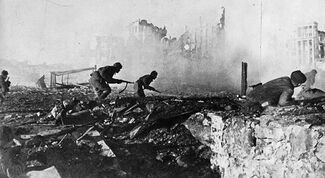Second Civil War of Fravina: Difference between revisions
No edit summary |
No edit summary |
||
| Line 45: | Line 45: | ||
* {{flagicon|Fravi Irises}} [[Bernard Cuvillier]] | * {{flagicon|Fravi Irises}} [[Bernard Cuvillier]] | ||
* {{flagicon|Fravi Irises}} [[Georges Lenoir]] | * {{flagicon|Fravi Irises}} [[Georges Lenoir]] | ||
* {{flagicon|Fravi Irises}} [[Alexandre Belmont]] | * {{flagicon|Fravi Irises}} [[Alexandre Belmont]] {{KIA}} | ||
* ''and others'' | * ''and others'' | ||
}} | }} | ||
| Line 53: | Line 53: | ||
* {{flagicon|Fravi Roses}} [[Alexandre Martin]] {{KIA}} | * {{flagicon|Fravi Roses}} [[Alexandre Martin]] {{KIA}} | ||
* {{flagicon|Fravi Roses}} [[Lucien LaClaire]] | * {{flagicon|Fravi Roses}} [[Lucien LaClaire]] | ||
* {{flagicon|Indigenous Congress}} [[Kitchi Cavalier]] | * {{flagicon|Indigenous Congress}} [[Kitchi Cavalier]] {{assassinated}} | ||
* ''and others'' | * ''and others'' | ||
}} | }} | ||
Revision as of 20:03, 13 August 2021
This article is incomplete because it is pending further input from participants, or it is a work-in-progress by one author. Please comment on this article's talk page to share your input, comments and questions. Note: To contribute to this article, you may need to seek help from the author(s) of this page. |
| Second Civil War of Fravina | |||||||
|---|---|---|---|---|---|---|---|
 Second Battle of Cartiercourt, 1945 | |||||||
| |||||||
| Belligerents | |||||||
|
Supported by |
Supported by | ||||||
| Commanders and leaders | |||||||
| Strength | |||||||
|
300,000 – 350,000 |
10,000-15,000 | ||||||
| Casualties and losses | |||||||
|
|
| ||||||
| 400,000–750,000 total casualties, including civilians and non-combatants | |||||||
The Second Civil War of Fravina was a civil war fought in Fravina from 1939 to 1948, fought between supporters of Brigadier General Joseph Peretti and supporters of Lieutenant Colnel Jacque De Mercy, resulting in the formation of the Second Republic of Fravina. The war began on 7 May 1939 with the East Orléans Army Mutiny, led by De Mercy, and the Port de Orléans Riots of 1939.
The origins of the war can be traced back to the death of Premier Lewis M. Nichols and the succession of his office. Both De Mercy and Peretti wanted to succeed Nichols, and when Peretti took the office, De Mercy mutinied. Those for De Mercy were colloquially referred to as the Roses, and were mainly composed of socialists and so-called Green Liberals. Those for Peretti were colloquially referred to as the Irises, and were mainly composed of fascists and so-called Blue Liberals.
Following the Fravina Indigenous Congress of 1941, the leaders of various Fravina indigenous groups chose to support the Roses. In opposition to this, various other indigineous leaders held the Fravina Northern Indigenous Conference of 1942, choosing to support the Irises.